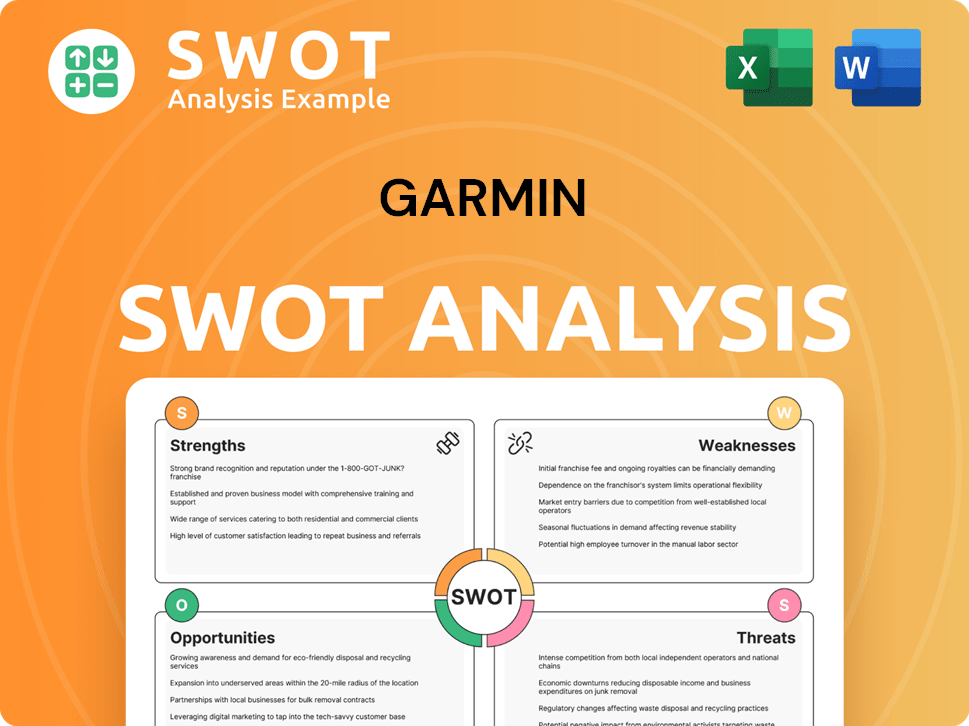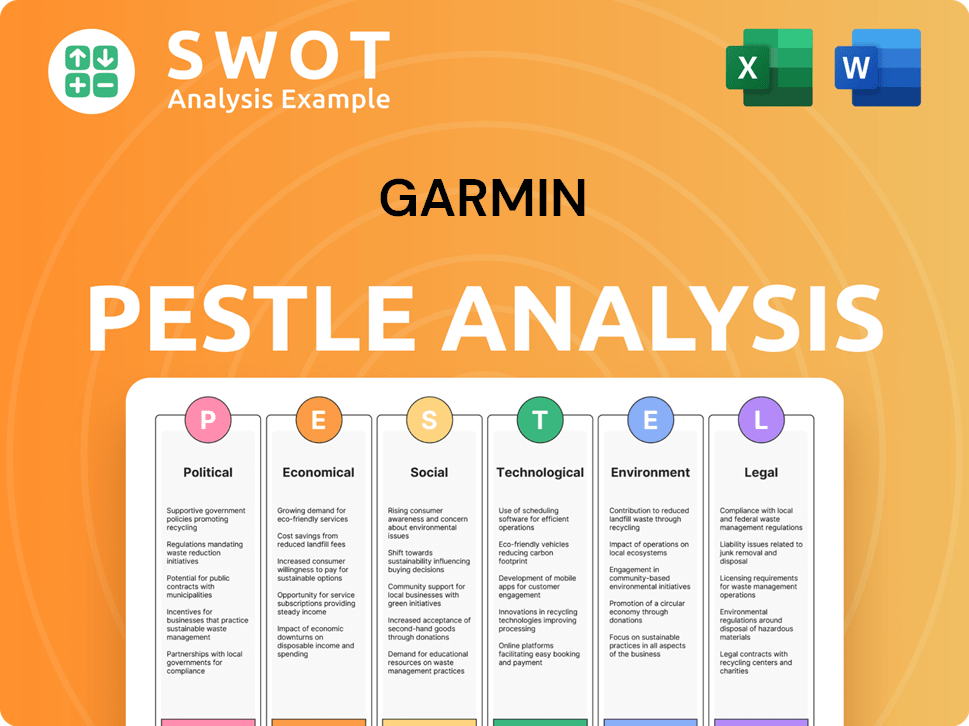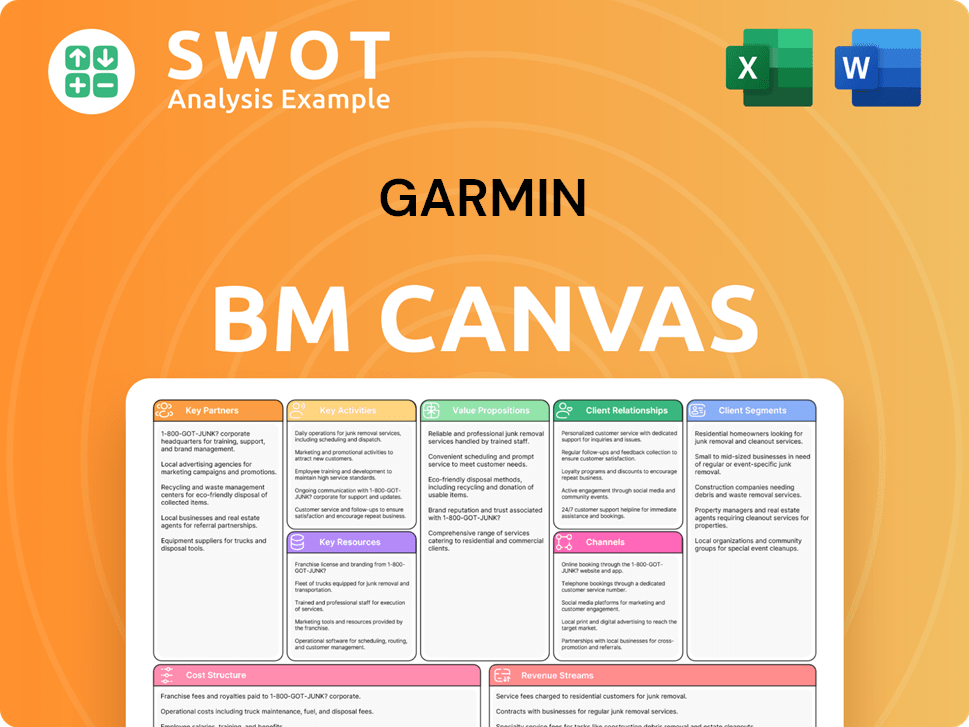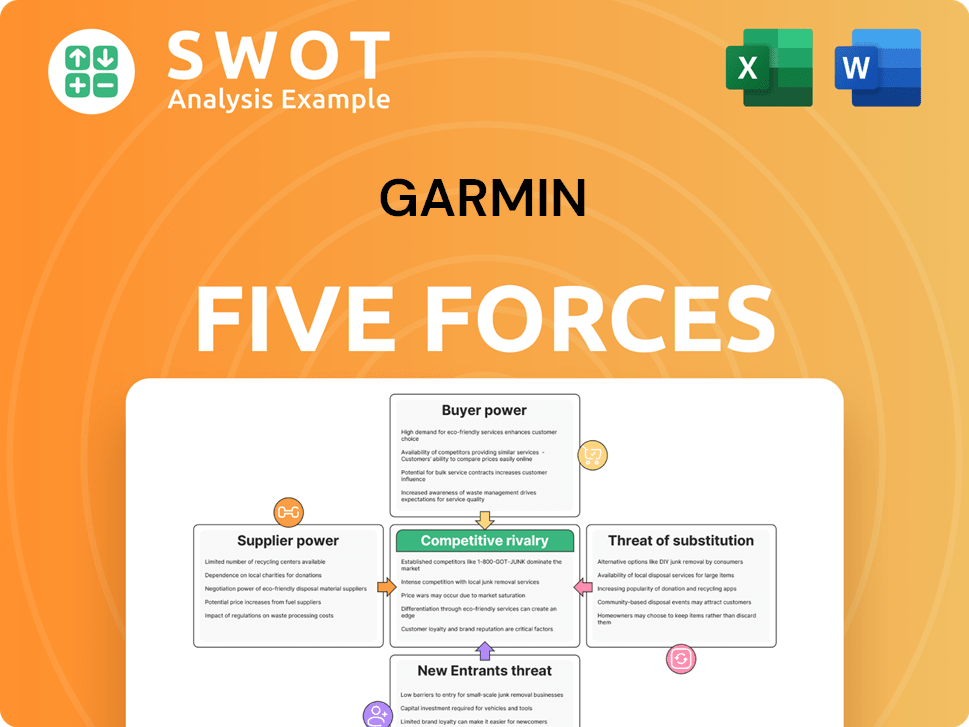Garmin Bundle
How Does Garmin Navigate Success?
Garmin, a titan in GPS technology and wearable devices, has consistently redefined the boundaries of innovation. From pioneering Garmin SWOT Analysis to creating cutting-edge products for diverse markets, the company's influence spans aviation, marine, fitness, and outdoor recreation. Garmin's robust financial performance, including a strong 2023 finish, highlights its enduring impact in the consumer electronics sector.

This deep dive into the Garmin company will explore how Garmin GPS navigation and other Garmin products have shaped the market. We'll uncover the secrets behind Garmin's success, from its core strategies and value propositions to its diverse revenue streams and competitive advantages. Understanding how Garmin works is essential for anyone looking to invest in or simply understand the evolution of technology.
What Are the Key Operations Driving Garmin’s Success?
The core operations of the Garmin company revolve around designing, developing, manufacturing, and marketing a wide array of navigation, communication, and information devices and applications. These operations are structured to create and deliver value across five key segments: Automotive, Aviation, Fitness, Marine, and Outdoor. Each segment caters to distinct customer needs, from pilots requiring precise navigation tools to athletes tracking their performance metrics.
The operational processes are vertically integrated, encompassing in-house research and development, advanced manufacturing facilities, and a robust global supply chain. This integration allows Garmin to maintain stringent quality control, accelerate product development cycles, and efficiently manage costs. The company's approach emphasizes specialized markets, which allows for deep expertise and tailored solutions that often surpass those of generalist competitors.
The value proposition of Garmin is centered on providing highly reliable, user-friendly, and technologically advanced products. For instance, in the aviation segment, Garmin's integrated flight decks and portable GPS devices offer critical safety and efficiency benefits. In the fitness market, its smartwatches and cycling computers provide comprehensive data and analytics for performance enhancement and health monitoring. The company's focus on specialized markets translates into customer benefits such as superior accuracy, durability, and specialized features, differentiating Garmin in competitive markets.
Vertical integration allows Garmin to control its supply chain, ensuring quality and efficiency. This approach supports faster product development and cost management. The company's manufacturing facilities, primarily in Taiwan, are key to this strategy.
Garmin focuses on specific sectors like aviation and fitness, providing tailored solutions. This specialization allows for deep expertise and competitive advantages. This strategy enhances customer satisfaction through superior product features and performance.
The global supply chain is characterized by sourcing components from various regions. Products are assembled in Garmin's own facilities. Strategic partnerships and a wide distribution network support global reach.
The company focuses on user-friendly and technologically advanced products. This approach enhances user experiences in various activities. Garmin aims to offer superior accuracy, durability, and specialized features.
In 2024, Garmin reported a revenue of approximately $3.02 billion in the second quarter, demonstrating strong performance across its segments. The Fitness segment saw a revenue increase, driven by the popularity of its smartwatches and cycling computers. The company's focus on innovation and customer satisfaction continues to drive its success.
- Garmin has a strong presence in the aviation sector, with integrated flight decks and portable GPS devices.
- The fitness segment offers comprehensive data and analytics for performance enhancement.
- The Marine segment provides advanced navigation and communication tools for boating enthusiasts.
- Garmin's commitment to specialized markets allows for deep expertise and tailored solutions.
For more details on how Garmin approaches its marketing, consider reading about the Marketing Strategy of Garmin.
Garmin SWOT Analysis
- Complete SWOT Breakdown
- Fully Customizable
- Editable in Excel & Word
- Professional Formatting
- Investor-Ready Format

How Does Garmin Make Money?
Understanding how the Garmin company generates revenue and its monetization strategies provides key insights into its business model. The company's success is rooted in a diversified approach, leveraging various segments to capture market share. This strategy allows Garmin to maintain a strong financial position and adapt to changing consumer preferences.
The primary revenue streams for Garmin are derived from the sale of its diverse product range. These include devices for fitness, outdoor activities, aviation, marine, and automotive applications. This multi-segment approach helps Garmin mitigate risks and capitalize on different market opportunities.
While specific figures for 2024 and 2025 are still emerging, the 2023 financial results offer a clear picture of revenue distribution. The Fitness segment led with $1.61 billion in revenue, followed by Outdoor at $1.52 billion. Aviation contributed $894 million, Marine $834 million, and Auto brought in $371 million. These numbers show the breadth of Garmin's market presence and the importance of each segment.
Besides direct product sales, Garmin employs several strategies to boost revenue. These include offering services and content, such as map updates and premium features, which contribute to recurring revenue streams. The company also focuses on cross-selling and ecosystem lock-in to encourage repeat purchases and customer loyalty.
- Recurring Revenue: Services like map updates and premium features add to the revenue base.
- Cross-selling: Encouraging customers to purchase additional products within the Garmin ecosystem. For example, a user with a smartwatch might also buy a cycling computer.
- Ecosystem Lock-in: The company's focus on durable, high-quality products and accessories fosters repeat purchases.
- Product Expansion: Continually expanding product categories within core segments to broaden the customer base.
Garmin PESTLE Analysis
- Covers All 6 PESTLE Categories
- No Research Needed – Save Hours of Work
- Built by Experts, Trusted by Consultants
- Instant Download, Ready to Use
- 100% Editable, Fully Customizable

Which Strategic Decisions Have Shaped Garmin’s Business Model?
The journey of the Garmin company has been marked by key milestones that have shaped its operational and financial trajectory. Early entry into the GPS market established a strong foundation in navigation technology. Strategic moves included expansion into diverse markets like aviation, marine, fitness, and outdoor recreation. This proactive approach leveraged its core GPS expertise across different industries.
Navigating operational challenges, such as global supply chain disruptions, has been managed through strategic inventory management and diversified manufacturing capabilities. The company's competitive advantages are multifaceted. Strong brand recognition, particularly among enthusiasts and professionals in its target markets, fosters significant customer loyalty. Technological leadership, rooted in continuous innovation in GPS accuracy, sensor technology, and software development, provides a sustained edge.
The company continuously adapts to new trends, such as the increasing demand for connected health devices and advanced outdoor navigation tools, by investing heavily in R&D and refining its product roadmaps to maintain its competitive edge and ensure its business model remains robust against emerging threats. For a deeper dive into how Garmin has strategically grown, check out the Growth Strategy of Garmin.
Early entry into the GPS market was a pivotal moment. Expansion into aviation, marine, fitness, and outdoor recreation markets followed. The launch of products like the Fenix series cemented its position in the premium wearable market.
Acquisitions of complementary technologies and companies enhanced product offerings. Strategic inventory management and diversified manufacturing helped navigate supply chain issues. Continuous investment in R&D ensures the company stays ahead of market trends.
Strong brand recognition and customer loyalty are significant advantages. Technological leadership in GPS and sensor technology provides a sustained edge. A vertically integrated business model allows for tighter control and faster time-to-market.
Global supply chain disruptions have been a challenge. The company has addressed these through strategic inventory management. Diversified manufacturing capabilities have also helped mitigate risks.
In 2024, Garmin reported strong financial results, driven by robust sales across its diverse product categories. The company's focus on innovation and expansion into new markets has contributed to its sustained growth. The company's revenue in 2024 was approximately $5.06 billion.
- Revenue growth driven by wearables and outdoor segments.
- Strong performance in aviation and marine markets.
- Continued investment in R&D to maintain a competitive edge.
- Expansion into new product categories, such as health monitoring devices.
Garmin Business Model Canvas
- Complete 9-Block Business Model Canvas
- Effortlessly Communicate Your Business Strategy
- Investor-Ready BMC Format
- 100% Editable and Customizable
- Clear and Structured Layout

How Is Garmin Positioning Itself for Continued Success?
The Garmin company holds a strong market position, especially in aviation, marine, and high-end outdoor and fitness wearables. It's known for quality and reliability, with a global presence across North America, Europe, and Asia-Pacific. Garmin products often enjoy high customer loyalty due to their specialized features and robust ecosystems.
However, the Garmin company faces risks like competition from tech giants and niche players, the need for constant innovation, and the impact of economic changes on consumer spending. Supply chain vulnerabilities are also a concern. Garmin's strategy focuses on innovation, expanding its connected device ecosystem, and exploring new applications for its technologies. The company aims to maintain its competitive edge through superior technology and strong brand recognition.
Garmin has a leading position in aviation, marine, and high-end wearables. They are known for high customer loyalty due to product quality and specialized features. Their global presence is extensive, with a strong market share in key regions.
Intense competition from larger tech companies and niche players poses a challenge. Constant innovation is needed to avoid obsolescence. Economic downturns and changes in consumer spending could affect sales. Supply chain issues also remain a potential risk.
Garmin's strategy involves continued innovation in core markets and expansion of its connected device ecosystem. They are exploring new applications for their core technologies. The company aims to maintain its competitive edge through superior technology and brand recognition.
Emphasis on R&D to deliver premium products. Focus on catering to the evolving needs of target demographics. Aim to differentiate offerings through technology and robust product ecosystems. Ensure continued relevance and profitability in the coming years.
In recent years, Garmin has shown resilience. While specific figures can fluctuate, the company generally maintains a strong financial position. Garmin focuses on premium products and expanding its digital ecosystem to drive growth.
- Revenue growth is often driven by new product releases and expansions into new markets.
- Profitability is supported by strong margins on premium products.
- The company's investment in R&D is a key factor in maintaining a competitive edge.
- Market trends show increasing demand for wearable technology and connected devices.
Garmin Porter's Five Forces Analysis
- Covers All 5 Competitive Forces in Detail
- Structured for Consultants, Students, and Founders
- 100% Editable in Microsoft Word & Excel
- Instant Digital Download – Use Immediately
- Compatible with Mac & PC – Fully Unlocked

Related Blogs
- What are Mission Vision & Core Values of Garmin Company?
- What is Competitive Landscape of Garmin Company?
- What is Growth Strategy and Future Prospects of Garmin Company?
- What is Sales and Marketing Strategy of Garmin Company?
- What is Brief History of Garmin Company?
- Who Owns Garmin Company?
- What is Customer Demographics and Target Market of Garmin Company?
Disclaimer
All information, articles, and product details provided on this website are for general informational and educational purposes only. We do not claim any ownership over, nor do we intend to infringe upon, any trademarks, copyrights, logos, brand names, or other intellectual property mentioned or depicted on this site. Such intellectual property remains the property of its respective owners, and any references here are made solely for identification or informational purposes, without implying any affiliation, endorsement, or partnership.
We make no representations or warranties, express or implied, regarding the accuracy, completeness, or suitability of any content or products presented. Nothing on this website should be construed as legal, tax, investment, financial, medical, or other professional advice. In addition, no part of this site—including articles or product references—constitutes a solicitation, recommendation, endorsement, advertisement, or offer to buy or sell any securities, franchises, or other financial instruments, particularly in jurisdictions where such activity would be unlawful.
All content is of a general nature and may not address the specific circumstances of any individual or entity. It is not a substitute for professional advice or services. Any actions you take based on the information provided here are strictly at your own risk. You accept full responsibility for any decisions or outcomes arising from your use of this website and agree to release us from any liability in connection with your use of, or reliance upon, the content or products found herein.